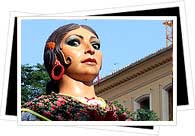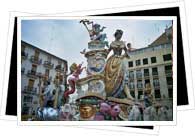Las Fallas Festival in Valencia, Spain
When: March 16-19
Where: Throughout the city
Official Website: www.fallas.com (site in Spanish, Valenciano, English, French and German)
 Las Fallas Traditions:
Las Fallas Traditions:
Launching - quite literally - the wild Valencian festival known as Las Fallas into action is the first of many "mascletàs," as five straight minutes of window-rattling firecracker explosions are set off on March 1st in the Plaza del Ayuntamiento- simply a signal that it's almost party time.
The real action kicks into high gear on the night of March 15th-16th, when the falleros have exactly one night to erect the elaborate and towering Ninot Fallas.You may be asking yourself exactly what is a "falla?" Each year, teams of local artists, designers and architects slave away for months designing and constructing brand-new, giant and elaborate structures of wood and papier-maché.
 You hear "papier-maché" and you think elementary school project, right? Well, these massive structures stand up to 15 meters (nearly 50 feet) high and can cost as much as €120,000! Appearing in cartoon-like form, the groups of figures depicted in the fallas are usually of both an ornamental and satirical nature, and are used to make a humorous comment about local, national or international events, personalities or characters from the past year.
You hear "papier-maché" and you think elementary school project, right? Well, these massive structures stand up to 15 meters (nearly 50 feet) high and can cost as much as €120,000! Appearing in cartoon-like form, the groups of figures depicted in the fallas are usually of both an ornamental and satirical nature, and are used to make a humorous comment about local, national or international events, personalities or characters from the past year.
Between March 16th and March 19th, herds of locals and tourists gaze up wide-eyed at the hundreds of incredibly crafted fallas, while judges and the falleros themselves award prizes to the cream of the crop. The top falla is then saved from the events of the March 19th and forever preserved in the Museo Fallero (Las Fallas Museum).
What happens on March 19th? When the clock strikes midnight, the Ninots - yes, those elaborate, expensive structures that took months to create - are set ablaze one-by-one in possibly the largest legal pyrotechnic event on earth! The event is not only a one-of-a-kind spectacle, but it also serves as a cleansing activity and a way to say "adios" to the past years events.
Along with the Ninot Fallas themselves, Las Fallas also features 24-hour street parties, paella competitions, parades, open-air concerts, traditional music, women donning typical Valencian dress, top-notch bullfights, brass band performances and, in true Valencian fashion, daily firecracker explosions and nightly fireworks shows.
Las Fallas History:
Like many Spanish festivals, Las Fallas was, in its origin, a simple pagan ritual that celebrated the Spring Equinox - the longest day of the year - and the subsequent coming of summer. The religious undertones and celebratory association with Saint José, the patron saint of carpenters, was added later by Spain's ultra-Catholic leaders. The history goes a little something like this:
In 15th-century Valencia, as autumn crept in and the days began to get shorter, artisans and carpenters had to spend the last few hours of the work day working by the light of oil lamps hung from crafted wooden "parots." When spring arrived, the days naturally became longer and it was evident that the pleasant days of spring and summer were just around the corner. No longer needing the lamps, artisans took to ceremoniously burning the "parots," standing them up in the middle of wood shavings, extra cuts of lumber and old junk accumulated with spring cleaning.
Over time, these workers added a creative touch to the ritual, decorating the lamp post with rags and a hat, thus giving it semblances of a doll or human form; these figures, often depicting someone from the neighborhood, that came to be known as a Ninot Falla (Doll Fire). The evolution of the festival of Las Fallas as we know it today took place during the second half of the 18th century, as the artisans and carpenters began to arrange these figures into groups to depict a certain scene, normally of a humorous nature.
